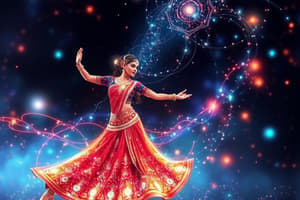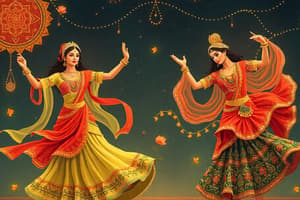Podcast
Questions and Answers
What is the language in which Tulsidas wrote the Ramcharitmanas?
What is the language in which Tulsidas wrote the Ramcharitmanas?
- Kannada
- Awadhi (correct)
- Bengali
- Tamil
Which saint emphasised devotion to Vishnu in Assam during the late fifteenth century?
Which saint emphasised devotion to Vishnu in Assam during the late fifteenth century?
- Mirabai
- Surdas
- Tulsidas
- Shankaradeva (correct)
What was the name of the saint who began the practice of setting up namghars or houses of recitation and prayer?
What was the name of the saint who began the practice of setting up namghars or houses of recitation and prayer?
- Dadu Dayal
- Ravidas
- Mirabai
- Shankaradeva (correct)
Which saint was Mirabai a disciple of?
Which saint was Mirabai a disciple of?
Which saint's devotion came to be known as Eka Sarana Nama Dharma?
Which saint's devotion came to be known as Eka Sarana Nama Dharma?
Which major works did Shankaradeva compose?
Which major works did Shankaradeva compose?
What development marked the institution of the Khalsa by Guru Gobind Singh in 1699?
What development marked the institution of the Khalsa by Guru Gobind Singh in 1699?
During which centuries did Kathak begin evolving into a distinct mode of dance?
During which centuries did Kathak begin evolving into a distinct mode of dance?
According to Baba Guru Nanak, what was irrelevant for attaining liberation?
According to Baba Guru Nanak, what was irrelevant for attaining liberation?
What did Baba Guru Nanak emphasize as the essence of his teaching?
What did Baba Guru Nanak emphasize as the essence of his teaching?
In which place was Kathak performed in the court under the Mughal emperors?
In which place was Kathak performed in the court under the Mughal emperors?
How did Jahangir view the Sikh community in the early-seventeenth century?
How did Jahangir view the Sikh community in the early-seventeenth century?
Which noble patronized Kathak, leading to its growth as a major art form?
Which noble patronized Kathak, leading to its growth as a major art form?
What aspects were emphasized in Kathak dance performances by the third quarter of the nineteenth century?
What aspects were emphasized in Kathak dance performances by the third quarter of the nineteenth century?
What term is used to refer to the Sikh community as a political entity after the institution of the Khalsa?
What term is used to refer to the Sikh community as a political entity after the institution of the Khalsa?
In which regions was Kathak firmly entrenched as a dance form by the third quarter of the nineteenth century?
In which regions was Kathak firmly entrenched as a dance form by the third quarter of the nineteenth century?
How did Baba Guru Nanak define liberation?
How did Baba Guru Nanak define liberation?
Which movement contributed to the evolution of Kathak as a distinct mode of dance?
Which movement contributed to the evolution of Kathak as a distinct mode of dance?
What did the influential Rajput families claim in the eighteenth century?
What did the influential Rajput families claim in the eighteenth century?
Who held the governorship of Gujarat in 1713?
Who held the governorship of Gujarat in 1713?
Which Rajput ruler founded a new capital at Jaipur?
Which Rajput ruler founded a new capital at Jaipur?
What architectural structures were housed within the hill forts built by Rajput chieftains?
What architectural structures were housed within the hill forts built by Rajput chieftains?
What did the Maratha campaigns into Rajasthan from the 1740s do?
What did the Maratha campaigns into Rajasthan from the 1740s do?
What led to the addition of Nagaur to the house of Jodhpur and the seizing of portions of Bundi by Amber?
What led to the addition of Nagaur to the house of Jodhpur and the seizing of portions of Bundi by Amber?
What was the name of the combined forces of the Sikhs in the eighteenth century?
What was the name of the combined forces of the Sikhs in the eighteenth century?
What system was introduced by the Sikhs to offer protection to cultivators?
What system was introduced by the Sikhs to offer protection to cultivators?
Who inspired the Khalsa with the belief that their destiny was to rule?
Who inspired the Khalsa with the belief that their destiny was to rule?
In which year did the Khalsa declare their sovereign rule by striking their own coin?
In which year did the Khalsa declare their sovereign rule by striking their own coin?
Who reunited the divided Sikh territories and established his capital at Lahore in 1799?
Who reunited the divided Sikh territories and established his capital at Lahore in 1799?
What kingdom arose out of a sustained opposition to Mughal rule, according to the text?
What kingdom arose out of a sustained opposition to Mughal rule, according to the text?
Flashcards are hidden until you start studying




